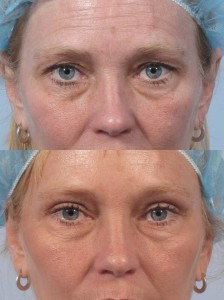How to fix a droopy eyelid
The video below where I tell how to fix a droopy eyelid is my most popular YouTube video with over 85,000 views at the time I am posting this blog entry. The take home message is that many people have droopy eyelids and are looking for ways to fix this problem.
Droopy eyelid vs. extra eyelid skin
In the video (which was filmed about 5 years ago, before I moved my practice to NYC – my hair is more gray now), I explain how a droopy eyelid is different from heavy eyelid skin and the treatments are very different.
Eyelid ptosis
In medical terminology, a droopy eyelid is called blepharoptosis or eyelid ptosis. This is when the eyelid sits in a low position, sometimes the margin of the upper eyelid (where the eyelashes are) can be so droopy that it covers your vision. Eyelid ptosis can happen on one side or on both. And one side can be worse than the other. This condition is sometimes related to contact lens wear, eye rubbing, and rarely it is associated with some serious conditions like a neurological condition or an aneurysm (and for this reason you should see your doctor if you have eyelid ptosis).
Common eyelid ptosis has two main forms
1. Ptosis related to muscle stretching or disinsertion
This is usually an age-related problem where the muscle tendon that lifts the eyelid has stretched or has become unattached from the eyelid support plate (tarsus). The correction is a surgery to tighten or reattach the muscle tendon (levator surgery). There is also a “scarless” technique of lifting the eyelid from behind the lid but not everyone is a candidate for this approach.
2. Congenital eyelid ptosis
This type of droopy eyelid occurs from birth and is related to poor development of the eyelid lifting muscle. The correction for this is a surgery that either advances the eyelid lifting tendon (to a greater degree than age-related ptosis correction) or a sling is created from the eyelid plate to the eyebrow which serves as a lifting force for the entire lid. Correction of congenital ptosis is more complex than age-related ptosis repair.
Extra eyelid skin
Heavy lids or extra upper eyelid skin is very different from eyelid ptosis. It is characterized by hanging, extra skin that can be wrinkled from sun-damage and aging. The medical term is upper dermatochalasis (not blepharochalasis, a term that is often misused to describe dermatochalasis). When the extra skin is lifted, the margin of the eyelid is resting in the right place- it’s not droopy as we see with eyelid ptosis, although extra eyelid skin and eyelid ptosis can happen at the same time (and they can be corrected at the same time).
Extra eyelid skin is best corrected with an upper eyelid lift, a procedure that takes away a strip of eyelid skin and sculpts the eyelids. This is one of the procedures I perform most often in my practice in New York, and I frequently combine it with laser resurfacing, botox, and fat injections to help people look younger and natural-looking. This is what an upper eyelid lift looks like:



